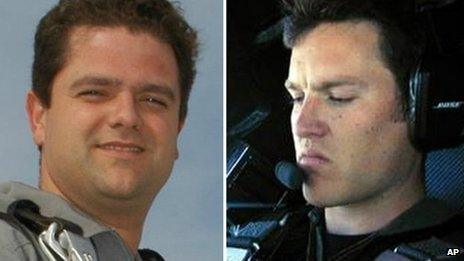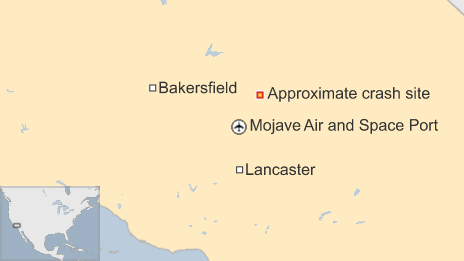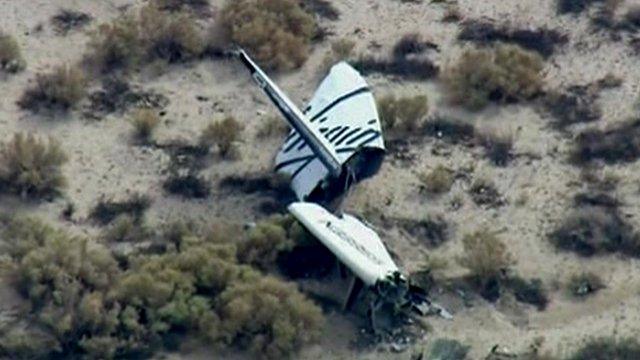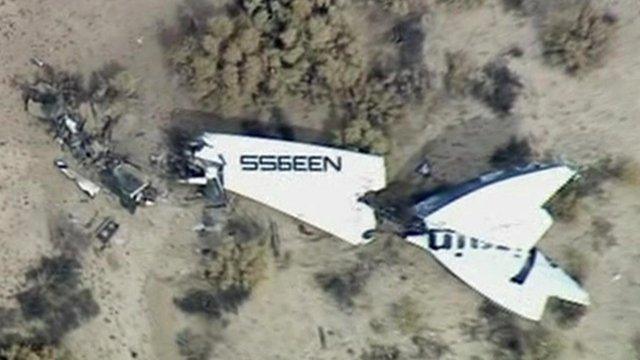Virgin Galactic crash: Mojave investigation under way
- Published
The moment the craft exploded was captured by a photographer
US officials have started to investigate why a Virgin Galactic space rocket crashed over California's Mojave Desert on a test flight.
Virgin chief Sir Richard Branson said he was "determined to find out what went wrong" and learn from the tragedy.
The co-pilot, named as Michael Alsbury, 39, died when SpaceShipTwo exploded shortly after take-off on Friday.
Local police said Peter Siebold, the pilot who survived the crash, had suffered "moderate to major injuries".
Scaled Composites, the company both pilots worked for, said, external Mr Siebold, 43, was "alert and talking with his family and doctors".
A National Transportation Safety Board (NTSB) team arrived in Mojave on Saturday.
NTSB acting chairman Christopher Hart said the team expected to be at the crash site for four to seven days, but added that the full investigation could take up to 12 months to complete.
Virgin Galactic would be free to conduct further flights during that time, he added.

Mike Alsbury - an employee of Scaled Composites, the firm behind SpaceShipTwo - was the pilot who died

NTSB investigators flew in to the Mojave Air and Space Port before heading to the desert crash site

The on-site investigation into the crash in the Mojave desert is expected to last several days
Speaking at the at the Mojave Air and Space Port, where the craft was being developed, Virgin Group founder Sir Richard said "nobody underestimates the risks involved in space travel".
Virgin had hoped to launch commercially in 2015. It has already taken more than 700 flight bookings at $250,000 (£156,000) each, with Sir Richard pledging to travel on the first flight.
"We owe it to our test pilots to find out what went wrong, and once we find out, if we can overcome it, we will make sure that the dream lives on," Sir Richard added.
Sir Richard Branson: "It's a horrible day for Virgin Galactic, for commercial space travel, it's a massive setback"

The pilots

Peter Siebold, left, survived the incident but his co-pilot, Michael Alsbury, died
Michael Alsbury
39-year-old was married with two children
Had 15 years of flying experience
First flew in the SpaceShipTwo in 2010
Flew craft's first rocket-powered run in April 2013
Peter Siebold
43-year-old is married with two children
Received his pilot's license when he was 16
Started working for Scaled Composites in 1996
Had spent 2,000 hours in 35 different fixed-wing aircraft

Sir Richard said Virgin Galactic and its partners had "been undertaking a comprehensive testing programme for many years and safety has always been our number one priority".
A team of between 13 and 15 NTSB investigators - including specialists in structures, systems, engines and vehicle performance - are taking part in the inquiry.
Their work would include detailed examination of all available data, work at the crash site and interviewing witnesses, Mr Hart said.
"This was a test flight and test flights are typically very well documented in terms of data," he told reporters.
He said that initial examination of the debris, which was scattered over an area measuring five miles from end to end, indicated there was an "in-flight break-up".
Police had initially secured the crash site in the Mojave Desert, north-east of Los Angeles, amid fears that some of the debris could be explosive.

'Serious anomaly'
SpaceShipTwo was flying its first test flight for nine months when it crashed shortly after take-off near the town of Bakersfield.
In a statement, Virgin Galactic said SpaceShipTwo had experienced "a serious anomaly", external after the craft separated from its launcher, an aircraft called WhiteKnightTwo.
WhiteKnightTwo landed safely.
It later emerged that the space craft was burning a new type of of rocket fuel never before used in flight, although officials said it had undergone extensive ground testing.
In a blog post, external on Friday, Sir Richard said everyone involved in the project was "deeply saddened".
"All our thoughts are with the families of everyone affected by this tragic event," he wrote.

David Shukman, BBC science editor

Even as details emerge of what went wrong, this is clearly a massive setback to a company hoping to pioneer a new industry of space tourism. Confidence is everything and this will not encourage the long list of celebrity and millionaire customers waiting for their first flight.
An innovative design combined with a new type of rocket motor make the development exceptionally hard. Despite an endless series of delays to its spacecraft, Virgin Galactic has over the years managed to maintain some very optimistic public relations and positive media coverage.
I interviewed Sir Richard Branson when he first announced the venture, and his enthusiasm and determination were undoubted. But his most recent promises of launching the first passenger trip by the end of this year had already started to look unrealistic some months ago.
This accident will delay plans even further. Space is never easy, and making it routine is even harder.
- Published31 October 2014
- Published31 October 2014

- Published31 October 2014

- Published31 October 2014
